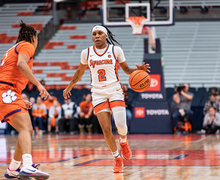SU professor creates rugs to document mother’s illness, womanhood
Courtesy of Ann Clarke
Ann Clarke is an associate professor of studio arts and dean emerita in Syracuse University’s College of Visual and Performing Arts.
The Daily Orange is a nonprofit newsroom that receives no funding from Syracuse University. Consider donating today to support our mission.
Ann Clarke, an associate professor of studio arts and dean emerita in the College of Visual and Performing Arts, is exhibiting rugs that document her role as a caretaker to her now 100-year-old mother. The exhibit also shows her historical identity as a woman and an artist at the Schweinfurth Art Center.
The solo exhibit is called “Lessons of Empathy in Wonderland” and runs until Jan. 10. Some of the rugs are up to 14 feet long and are a composite of the past, present and future — a map of words and numbers alongside images and silhouettes.
“It’s that compression of a grocery list from today with a letter from the 1950s,” Clarke said. “In a way, it’s kind of a scrapbook, all compressed in one piece.”
The bigger rugs are labor-intensive, taking two months to create at 40 hours per week, but Clarke said that’s something she likes about them. She can work on a rug for months before finishing it, creating a giant work of art from the repetitive and smaller act of knitting and yarn work.

Some of the rugs created by SU professor and VPA dean emeritus Ann Clarke are up to 14 feet long. Courtesy of Ann Clarke
Davana Robedee, program director and a curator in Clarke’s current exhibition, stressed the large-scale importance of Clarke’s work.
“Historically, fiber art has been considered women’s work, and as many things go with women’s work, has been undervalued,” Robedee said. “We’ve seen a shift in that over the years where fiber art really is stepping up and a lot of fiber practices are becoming more valued in the contemporary world.”
Clarke herself may have undervalued fiber art when it was first introduced to her. Her mother taught Clarke most of the techniques she used when she was young, but in the name of being a housewife, not an artist.
“I actually learned the techniques not through an art frame but through a frame of women’s work, and the domestic, not considered art. So that certainly informed the work going forward,” Clarke said.
Wool is the primary material Clarke uses in her rugs, a fabric that feels very familiar to Clarke, who was born in Rochester and raised through cold upstate New York winters.
Errol Willett, an associate professor of studio arts, began teaching at SU the same fall as Clarke did, 21 years ago. He owns one of Clarke’s rugs in his home. The use of fabric is a major factor in making the pieces so meaningful, he said.

A main source of inspiration behind Clarke’s rugs are from being a caretaker for her 100-year-old mother. Courtesy of Ann Clarke
“Something about the tactility of fibers and its relationship to domestic space and to the sort of comfort, gives the wall pieces this additional power,” Willett said.
Clarke’s mother, Betty, is 100 years old and has Alzheimer’s disease. Clarke said a concept she is interested in has been the reversal of her and her mother’s roles as she sometimes sees her mother as her child in terms of caregiving. It’s that relationship that inspired her piece “Mother and Child.” This caretaking role allowed Clarke to understand more about how her mother experiences time, a concept that she continues to incorporate into most of her work.
Her series “Eye Portals” features smaller circular rugs depicting one eye of various women who have been important to Clarke. These include Clarke’s older family members, her mother, her twin sister and also important women in history. She has an eye for Amelia Bloomer, an early suffragette who is credited with being one of the first women to wear pants and an eye for Mary Cass, who became one of the first women to lead a Fortune 500 company.
“It’s really situating me, my family, and the women I know on the timeline of the history of women, the women who stood before,” Clarke said.
Published on October 25, 2020 at 11:06 pm
Contact Sydney: [email protected]





